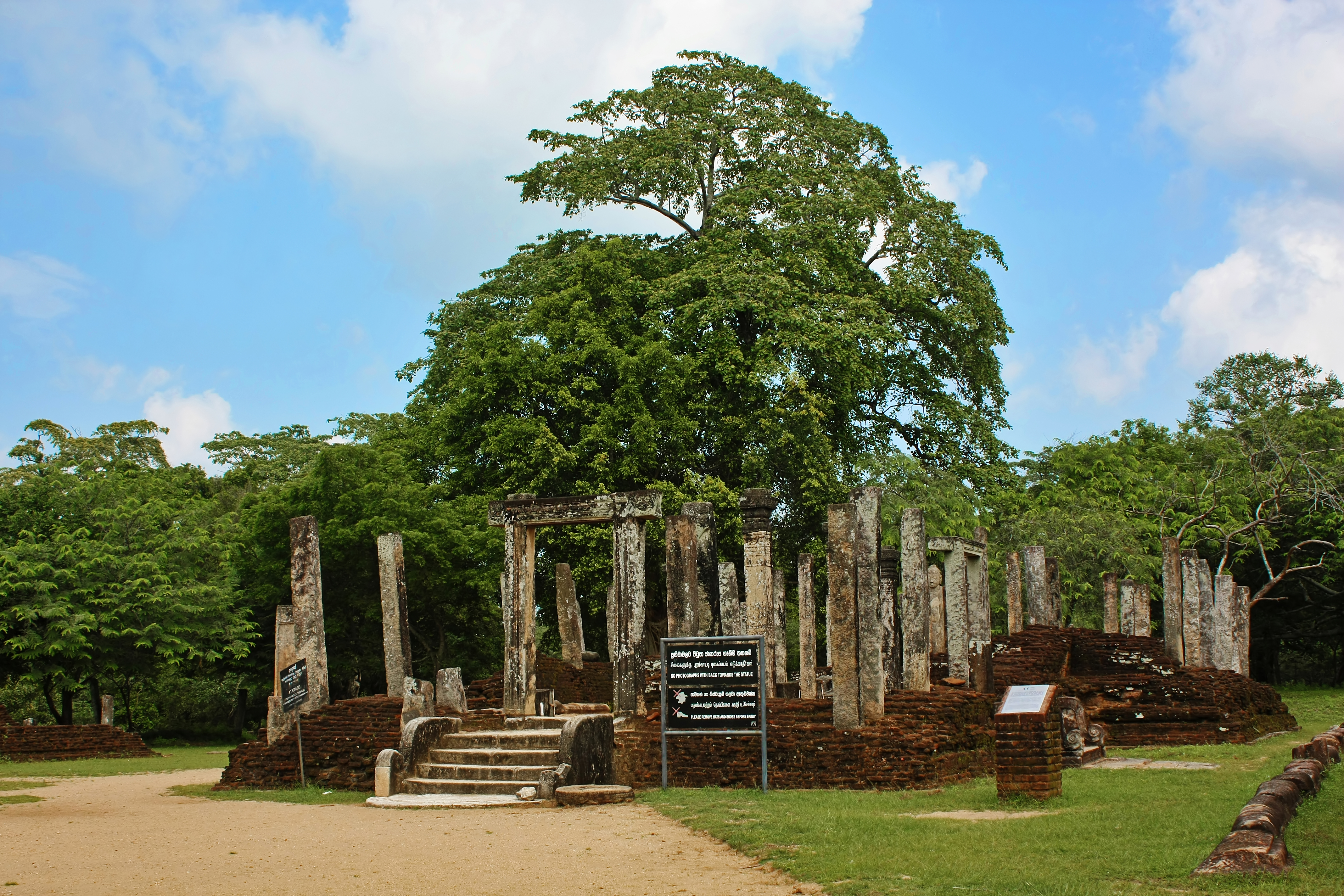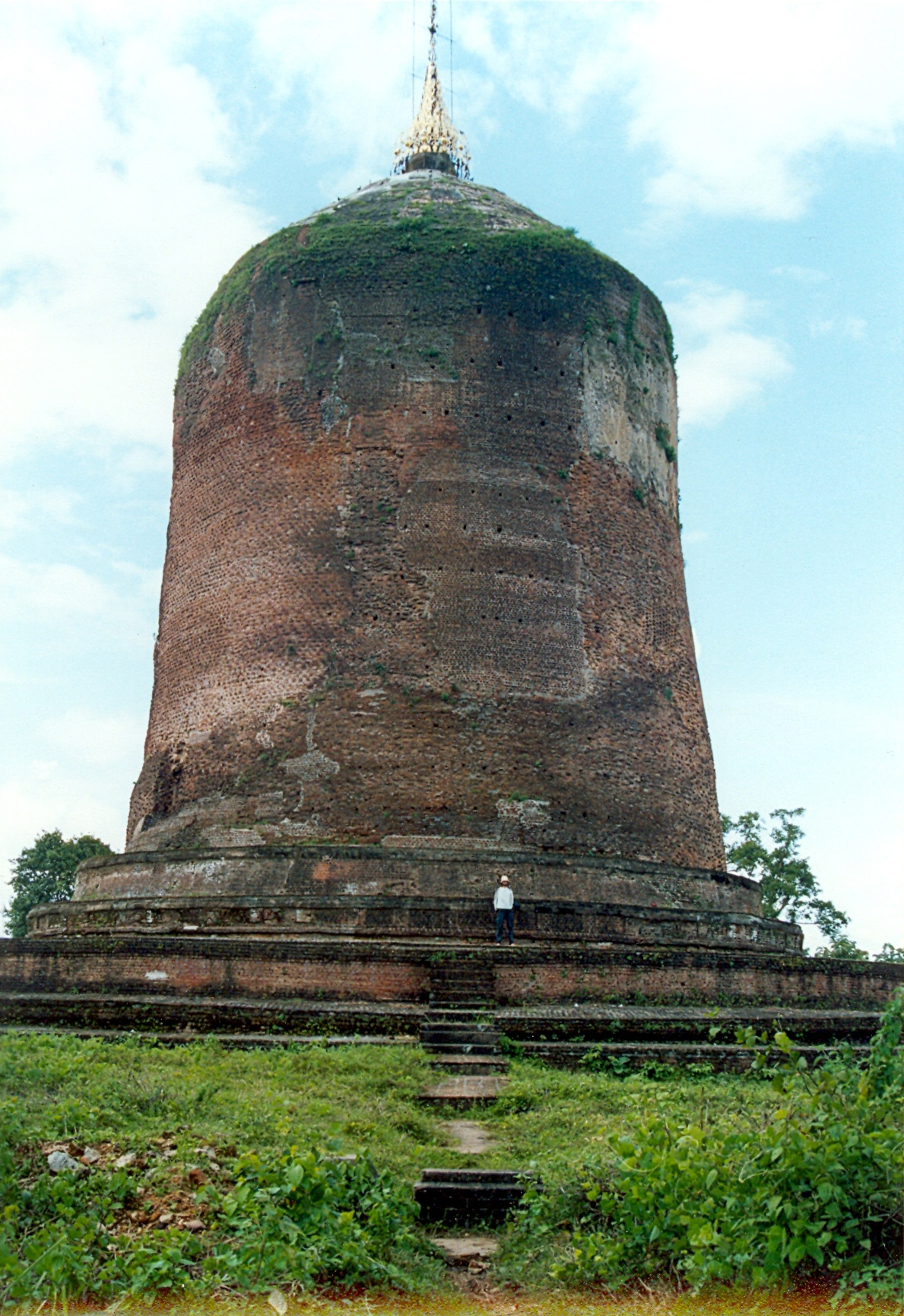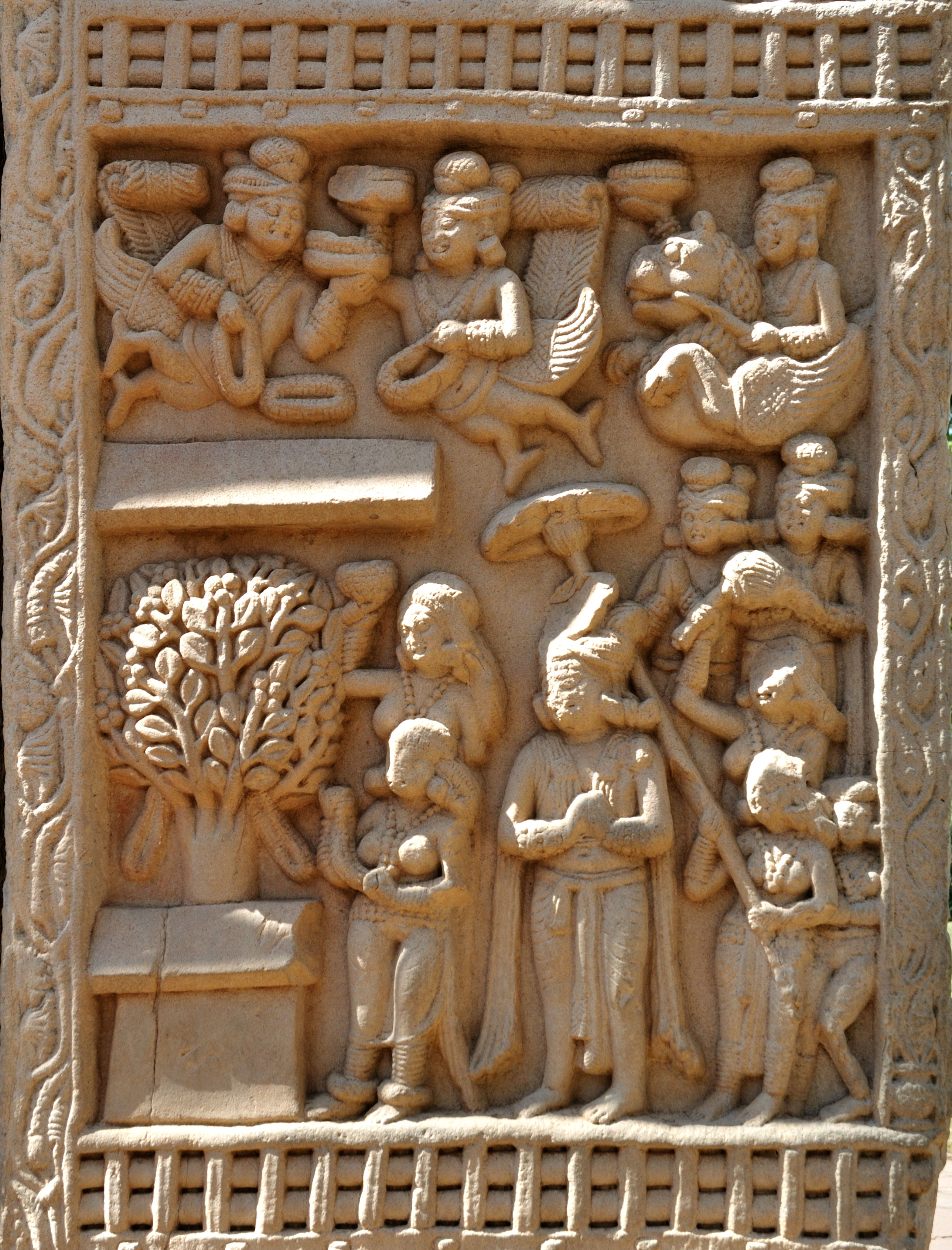|
Cetiya
upright=1.25, Phra Pathom Chedi, one of the biggest Chedis in Thailand; in Thai, the term Chedi (cetiya) is used interchangeably with the term Stupa Cetiya, "reminders" or "memorials" (Sanskrit ''caitya''), are objects and places used by Buddhism, Buddhists to remember Gautama Buddha.Kalingabodhi jātaka, as quoted in John Strong, ''Relics of the Buddha'' (Princeton: Princeton University Press, 2004), 19 According to Damrong Rajanubhab, four kinds are distinguished in the Pāli Canon: "Relic hatu Memorial aribhoga Teaching hamma and votive desaka" Griswold, in contrast, states that three are traditional and the fourth, the Buddha Dhamma, was added later to remind monks that the true memory of Gautama Buddha can be found in his teachings. While these can be broadly called Buddhist symbolism, the emphasis tends to be on a historical connection to the Buddha and not a metaphysical one. In pre-Buddhist India ''caitya'' was a term for a shrine or holy place in the landscape, gener ... [...More Info...] [...Related Items...] OR: [Wikipedia] [Google] [Baidu] |
Stupas In Sri Lanka
Stupas, also called and cetiyas, are considered an outstanding type of architectural creation of ancient Sri Lanka. Under the influence of Buddhism, there were several changes in the field of architecture in Sri Lanka. The stupa commands a prominent place among these changes. The Stupa is also known by synonymous names such as Chaithya, Dagaba, Thupa, Seya and Vehera. Stupas designed and constructed in Sri Lanka are the largest brick structures known to the pre-modern world.Silva, R. 1990, "Bricks – A unit of construction in ancient Sri Lanka", ICTAD Journal, Vol.2, No. 1, pp. 21-42, Colombo. After Rev. Mahinda thero introduced Buddhism during the reign of King Devanampiya Tissa of Anuradhapura (307267 BCE), in the Sri Lanka’s ancient sacred capital of Anuradhapura, the king built the Anuradhapura Maha Viharaya, a mahavihara, after dedicating the Nandana and Mahamega royal pleasure gardens to the Maha Sangha. The earliest monument found in Sri Lanka is the Stupa, which is des ... [...More Info...] [...Related Items...] OR: [Wikipedia] [Google] [Baidu] |
Stupa
A stupa ( sa, स्तूप, lit=heap, ) is a mound-like or hemispherical structure containing relics (such as ''śarīra'' – typically the remains of Buddhist monks or nuns) that is used as a place of meditation. In Buddhism, circumambulation or ''pradakhshina'' has been an important ritual and devotional practice since the earliest times, and stupas always have a ''pradakhshina'' path around them. The original South Asian form is a large solid dome above a tholobate or drum with vertical sides, which usually sits on a square base. There is no access to the inside of the structure. In large stupas there may be walkways for circumambulation on top of the base as well as on the ground below it. Large stupas have or had ''vedikā'' railings outside the path around the base, often highly decorated with sculpture, especially at the torana gateways, of which there are usually four. At the top of the dome is a thin vertical element, with one of more horizontal discs spreadin ... [...More Info...] [...Related Items...] OR: [Wikipedia] [Google] [Baidu] |
Relic Of The Tooth Of The Buddha
The relic of the tooth of Buddha (Pali ''danta dhātuya'') is venerated in Sri Lanka as a sacred cetiya relic of Lord Buddha, who is the founder of Buddhism, the fourth largest religion worldwide. History The relic in India According to Sri Lankan legends, when the Buddha died in 543 BC, his body was cremated in a sandalwood pyre at Kushinagar and his left canine tooth was retrieved from the funeral pyre by his disciple, Khema. Khema then gave it to King Brahmadatte for veneration. It became a royal possession in Brahmadatte's country and was kept in the city of Dantapuri (modern Puri, Odisha). A belief grew that whoever possessed the tooth relic had a divine right to rule that land. The '' Dāṭhāvaṃsa'' recounts the tale of a war fought over the relic 800 years later between Guhasiva of the republic of Kalinga and a king named Pandu. The relic in Sri Lanka Legend states the Abhayagiri vihāra was first appointed custodianship of the relic when it was brought to the i ... [...More Info...] [...Related Items...] OR: [Wikipedia] [Google] [Baidu] |
Burmese Pagoda
Burmese pagodas are stupas that typically house Buddhist relics, including relics associated with Buddha. Pagodas feature prominently in Myanmar's landscape, earning the country the moniker "land of pagodas." According to 2016 statistics compiled by the State Sangha Maha Nayaka Committee, Myanmar is home to 1,479 pagodas exceeding in height, a quarter of which are located in Sagaing Region. Several cities in the country, including Mandalay and Bagan, are known for their abundance of pagodas. Pagodas are the site of seasonal pagoda festivals. Burmese pagodas are enclosed in a compound known as the ''aran'' (အာရာမ်, from Pali ''ārāma''), with gateways called ''mok'' (မုခ်, from Pali ''mukha'') at the four cardinal directions. The platform surrounding a Burmese pagoda is called a ''yinbyin'' (ရင်ပြင်). Terms In the Burmese language, pagodas are known by a number of various terms. The umbrella term ''phaya'' (, pronounced ), which derives fr ... [...More Info...] [...Related Items...] OR: [Wikipedia] [Google] [Baidu] |
Aniconism In Buddhism
__NOTOC__ Since the beginning of the serious study of the history of Buddhist art in the 1890s, the earliest phase, lasting until the 1st century CE, has been described as aniconic; the Gautama Buddha, Buddha was only represented through symbols such as an Hetoimasia, empty throne, Bodhi tree, a riderless horse with a parasol floating above an empty space (at Sanchi), Buddha footprint, Buddha's footprints, and the dharma wheel. This aniconism is relation to the image of the Buddha could be in conformity with an ancient Buddhist prohibition against showing the Buddha himself in human form, known from the ''Sarvastivada vinaya'' (rules of the early Buddhist school of the Sarvastivada):"Since it is not permitted to make an image of the Buddha's body, I pray that the Buddha will grant that I can make an image of the attendant Bodhisattva. Is that acceptable?" The Buddha answered: "You may make an image of the Bodhisattava".Although there is still some debate, the first anthropomorphic ... [...More Info...] [...Related Items...] OR: [Wikipedia] [Google] [Baidu] |
śarīra
Śarīra is a generic term referring to Buddhist relics, although in common usage it usually refers to pearl or crystal-like bead-shaped objects that are purportedly found among the cremated ashes of Buddhist spiritual masters. Relics of the Buddha after cremation are termed ''dhātu'' in the '' Mahaparinibbana Sutta''. Śarīra are held to emanate or incite 'blessings' and 'grace' (Sanskrit: adhiṣṭhāna) within the mindstream and experience of those connected to them. Sarira are also believed to ward off evil in the Himalayan Buddhist tradition. Terminology Śarīraḥ (pronounced /ɕɐɽiːɽɐh/) means "body" in Sanskrit. When used in Buddhist Hybrid Sanskrit texts to mean "relics", it is always used in the plural: śarīrāḥ. The term ''ringsel'' is a loanword from the Tibetan རིང་བསྲེལ (''ring bsrel''). Both of these terms are ambiguous in English; they are generally used as synonyms, although according to some interpretations, ringsels are a sub ... [...More Info...] [...Related Items...] OR: [Wikipedia] [Google] [Baidu] |
Bodh Gaya
Bodh Gaya is a religious site and place of pilgrimage associated with the Mahabodhi Temple Complex in Gaya district in the Indian state of Bihar. It is famous as it is the place where Gautama Buddha is said to have attained Enlightenment ( pi, bodhi, pi-Latn) under what became known as the Bodhi Tree. Since antiquity, Bodh Gaya has remained the object of pilgrimage and veneration both for Hindus and Buddhists. In particular, archaeological finds including sculptures show that the site was in use by Buddhists since the Mauryan period. For Buddhists, Bodh Gaya is the most important of the main four pilgrimage sites related to the life of Gautama Buddha, the other three being Kushinagar, Lumbini, and Sarnath. In 2002, Mahabodhi Temple, located in Bodh Gaya, became a UNESCO World Heritage Site. History Bodh Gaya is considered to be the holiest site in Buddhism. Known as Uruwela in the Buddha's time, it is situated by the bank of Lilajan River. The first temple at the site was ... [...More Info...] [...Related Items...] OR: [Wikipedia] [Google] [Baidu] |
Dharmakāya
The ''dharmakāya'' ( sa, धर्म काय, "truth body" or "reality body", zh, t=法身, p=fǎshēn, ) is one of the three bodies (''trikāya'') of a buddha in Mahāyāna Buddhism. The ''dharmakāya'' constitutes the unmanifested, "inconceivable" (''acintya'') aspect of a buddha out of which buddhas arise and to which they return after their dissolution. Buddhas are manifestations of the ''dharmakāya'' called the ''nirmāṇakāya'', "transformation body". The Dhammakāya tradition of Thailand and the ''Tathāgatagarbha sūtras'' of the ancient Indian tradition view the ''dharmakāya'' as the '' ātman'' (true self) of the Buddha present within all beings. Origins and development Pali Canon In the Pāli Canon, Gautama Buddha tells Vasettha that the Tathāgata (the Buddha) is ''dhammakaya'', the "truth-body" or the "embodiment of truth", as well as ''dharmabhuta'', "truth-become", that is, "one who has become truth." During the Buddha's life great veneration was ... [...More Info...] [...Related Items...] OR: [Wikipedia] [Google] [Baidu] |
Buddha Footprint
Buddha's footprints ( sa, Buddhapada) are Buddhist icons shaped like an imprint of Gautama Buddha's foot or both feet. There are two forms: natural, as found in stone or rock, and those made artificially. Many of the "natural" ones are acknowledged not to be genuine footprints of the Buddha, but rather replicas or representations of them, which can be considered ''cetiya'' (Buddhist relics) and also an early aniconic and symbolic representation of the Buddha. Symbolism Footprints of the Buddha abound throughout Asia, dating from various periods. Japanese author , who spent years tracking down the footprints in many Asian countries, estimates that he found more than 3,000 such footprints, among them about 300 in Japan and more than 1,000 in Sri Lanka. They often bear distinguishing marks, such as a Dharmachakra at the centre of the sole, or the 32, 108 or 132 auspicious signs of the Buddha, engraved or painted on the sole. A depression atop Sri padaya in Sri Lanka is among the ... [...More Info...] [...Related Items...] OR: [Wikipedia] [Google] [Baidu] |
Buddharupa
Much Buddhist art uses depictions of the historical Buddha, Gautama Buddha, which are known as Buddharūpa (literally, "Form of the Awakened One") in Sanskrit and Pali. These may be statues or other images such as paintings. The main figure in an image may be someone else who has obtained Buddhahood, or a boddhisattva, especially in the various traditions of Mahayana Buddhism. Other Buddhas and bodhisattvas in art have become increasingly common over the centuries, perhaps now outnumbering images of the historical Buddha. In its first centuries Buddhism was largely or entirely aniconic, not showing the person of Buddha except by symbols and relics. This changed, and figures of the Buddha became very common in the art of Gandhara and Gupta art. As forms of esoteric Buddhism developed, other figures from the expanding array of Buddhist sacred persons became more prominent. In Theravada Buddhism this was much less the case, and figures of the historical Buddha remain the most ... [...More Info...] [...Related Items...] OR: [Wikipedia] [Google] [Baidu] |
Great Departure
The Great Renunciation or Great Departure is the traditional term for the departure of Gautama Buddha ( BCE) from his palace at Kapilavastu to live a life as an ascetic ( sa, śrāmaṇa, italic=yes, pi, sāmaṇa, italic=yes). It is called the Great Renunciation because it is regarded as a great sacrifice. Most accounts of this event can be found in post-canonical Buddhist texts from several Buddhist traditions, which are the most complete. These are, however, of a more mythological nature than the early texts. They exist in Pāli, Sanskrit and Chinese language. According to these accounts, at the birth of Prince Siddhārtha Gautama, the Buddha-to-be, Brahmin priests predicted that he would either become a world teacher or a world ruler. To prevent his son from turning to religious life, Prince Siddhārtha's father and ''rāja'' of the Śākya clan Śuddhodana did not allow him to see death or suffering, and distracted him with luxury. During his childhood, Prince Siddhārt ... [...More Info...] [...Related Items...] OR: [Wikipedia] [Google] [Baidu] |
Greco-Buddhism
Greco-Buddhism, or Graeco-Buddhism, is the cultural syncretism between Hellenistic culture and Buddhism, which developed between the fourth century BC and the fifth century AD in Gandhara, in present-day north-western Pakistan and parts of north-east Afghanistan. It was a cultural consequence of a long chain of interactions begun by Greek forays into India from the time of Alexander the Great. A few years after Alexander's death, the Easternmost fringes of the empire of his general Seleucus were lost in a war with the Mauryan Empire, under the reign of Chandragupta Maurya. The Mauryan Emperor Ashoka would convert to Buddhism and spread the religious philosophy throughout his domain, as recorded in the Edicts of Ashoka. This spread to the Greco-Bactrian kingdom, which itself seceded from the Seleucid empire. Within its borders, the Greek fondness for statuary produced the first statues of the Buddha, leading ultimately to the modern tradition. Following the collapse of the Maur ... [...More Info...] [...Related Items...] OR: [Wikipedia] [Google] [Baidu] |









.jpg)
.jpeg/1200px-Gandhara_Buddha_(tnm).jpeg)